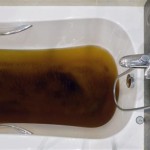Most Expensive Bathtub Material in the World
The selection of bathtub material significantly impacts its cost, durability, aesthetics, and overall bathing experience. While acrylic and cast iron remain popular choices for their affordability and practicality, the realm of luxury bathtubs explores more exotic and expensive materials. Identifying the single "most expensive" material is challenging, as the price is influenced by sourcing, craftsmanship, design complexity, and market fluctuations. However, certain materials consistently rank among the highest in cost due to their rarity, inherent properties, and the extensive labor required for their fabrication.
This article will explore some of the most expensive bathtub materials available, discussing their distinctive characteristics, contributing factors to their high price points, and the overall value proposition they offer to discerning homeowners. It is important to remember that the ultimate cost of a bathtub is a comprehensive calculation, factoring in not just the raw material but also the artistry, engineering, and brand prestige involved.
Precious Metals: The Pinnacle of Bathtub Luxury
Bathtubs crafted from precious metals like gold, silver, and copper represent the most extravagant and costly options. The sheer value of the raw material is the primary driver of their elevated price. Gold, in particular, is prized for its inherent resistance to corrosion, timeless luster, and association with opulence. A bathtub made entirely of gold, even a relatively thin layer applied over a structural substrate, can command a price well into the millions of dollars.
The creation of a gold bathtub necessitates specialized skills and meticulous craftsmanship. The metal must be carefully shaped and molded, often using time-honored techniques, to ensure structural integrity and a flawless finish. The application of gold leaf or electroplating requires specialized equipment and expertise to achieve uniform coverage and prevent imperfections. Furthermore, the weight of precious metals can pose significant engineering challenges, requiring reinforced flooring and specialized plumbing connections.
Silver, while less expensive than gold, still represents a significant investment. Its antimicrobial properties and attractive sheen make it a desirable material for luxury bathtubs. However, silver is prone to tarnishing, requiring regular maintenance to preserve its luster. Copper, with its natural warmth and antibacterial qualities, is another metal sometimes used in bathtub construction, though typically as a lining or decorative element rather than the primary structural material. The cost of a copper bathtub depends heavily on the gauge of the metal, the intricacy of the design, and the level of handcraftsmanship involved.
Exotic Stone: Natural Beauty at a Premium
Certain rare and visually striking stones, such as onyx, marble, and granite, are highly sought after for creating luxurious and aesthetically compelling bathtubs. The cost of these materials is directly related to their rarity, the difficulty of extraction, and the complexity of shaping them into a functional and comfortable bathtub. Onyx, with its translucent properties and captivating banding patterns, is particularly prized for its visual impact. A bathtub carved from a single block of onyx can be a breathtaking centerpiece in a high-end bathroom.
The process of quarrying and transporting large blocks of stone is inherently expensive and labor-intensive. The stone must be carefully extracted to avoid damage and transported to a facility equipped with specialized cutting and shaping equipment. Artisans then use a combination of hand tools and advanced machinery to carve the stone into the desired shape, ensuring smooth surfaces and precise dimensions. The inherent imperfections and variations in natural stone add to its unique character but also require careful planning and execution to minimize waste and ensure structural integrity.
Marble, with its timeless elegance and variety of colors and patterns, is another popular choice for luxury bathtubs. However, certain rare and highly figured marbles, such as Calacatta marble from Italy, command a premium price due to their scarcity and exceptional visual appeal. Granite, known for its durability and resistance to staining, is also used in bathtub construction, though its weight and difficulty to shape can increase its cost. The sealing of natural stone bathtubs is a crucial step to prevent water damage and staining, adding to the overall cost of ownership.
High-Tech Composites: Combining Luxury and Performance
Beyond natural materials, advanced composite materials are also pushing the boundaries of bathtub design and cost. These materials combine the best properties of different substances to create bathtubs that are lightweight, durable, and visually stunning. Carbon fiber, a high-strength, lightweight material commonly used in aerospace and automotive applications, is increasingly being used in high-end bathtub construction.
The production of carbon fiber bathtubs involves layering sheets of carbon fiber fabric over a mold and then infusing them with resin. The resulting structure is incredibly strong and rigid yet significantly lighter than traditional materials like cast iron or stone. This reduced weight simplifies installation and reduces the load on the bathroom floor. Carbon fiber can also be molded into complex shapes and finished with a variety of colors and textures, allowing for highly customized designs. However, the cost of carbon fiber and the labor-intensive manufacturing process make these bathtubs exceptionally expensive.
Other advanced composite materials, such as Corian and Solid Surface, are also used in luxury bathtub construction. These materials are non-porous, stain-resistant, and can be seamlessly molded into a variety of shapes. While not as expensive as carbon fiber, they still represent a premium option compared to standard acrylic or fiberglass bathtubs. The ability to customize these materials with integrated lighting, sound systems, and other features further enhances their appeal and adds to their overall cost.
The price of a bathtub is also affected by added features like hydrotherapy jets, integrated heating systems, chromatherapy (color therapy) and aromatherapy dispensers. These additions require complex plumbing and electrical integration, further increasing the cost of the bathtub. Smart bathtubs are now emerging in the market, boasting features like automated filling, temperature control and even self-cleaning capabilities. These technologically advanced bathtubs are naturally positioned at the higher end of the price spectrum.
The cost of installation must also be considered. Installing a heavy stone or precious metal bathtub requires specialized skills and equipment. Reinforced flooring may be necessary, and the plumbing connections must be carefully inspected to ensure proper drainage and prevent leaks. The complexity of the installation process can significantly increase the overall cost of the bathtub project.
Ultimately, the "most expensive bathtub material" is a subjective designation dependent on specific market conditions, design complexity, and individual preferences. While gold and rare stones represent the pinnacle of bathtub luxury, advanced composite materials offer a compelling combination of performance and aesthetics. The discerning homeowner should carefully consider their budget, design preferences, and desired features when selecting the perfect bathtub for their needs.

A Guided Tour To The World S Most Expensive Baths

A Guided Tour To The World S Most Expensive Baths

Blissful Bathing 5 Of The Most Luxurious Bathtubs In World

Blissful Bathing 5 Of The Most Luxurious Bathtubs In World

Spectacular 1 Million Bathtubs Revealed For New Xxii Carat Villas In Dubai

Blissful Bathing 5 Of The Most Luxurious Bathtubs In World

7 Awesome Tub Materials For Luxury Bathrooms Maison Valentina Blog

Best Gemstone Materials To Use For Your Bathtub
Baldi Harrods Continues Their Love Affair With Unique 790k Crystal Bathtub Tmzstlyle Livejournal

How To Choose Between Granite Bathtub Quartz And Marble
Related Posts








